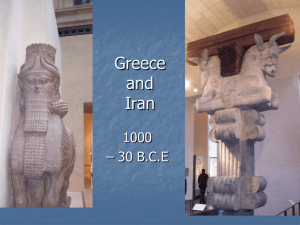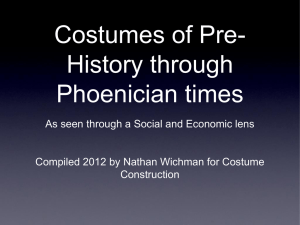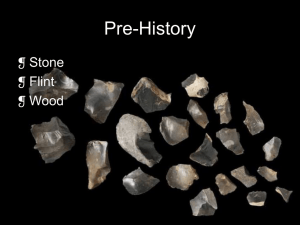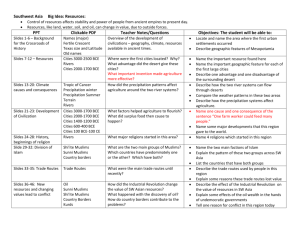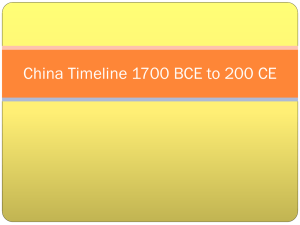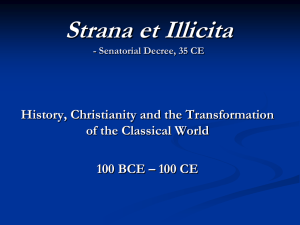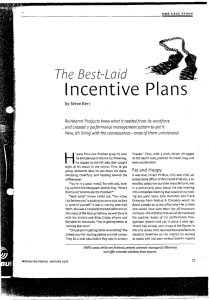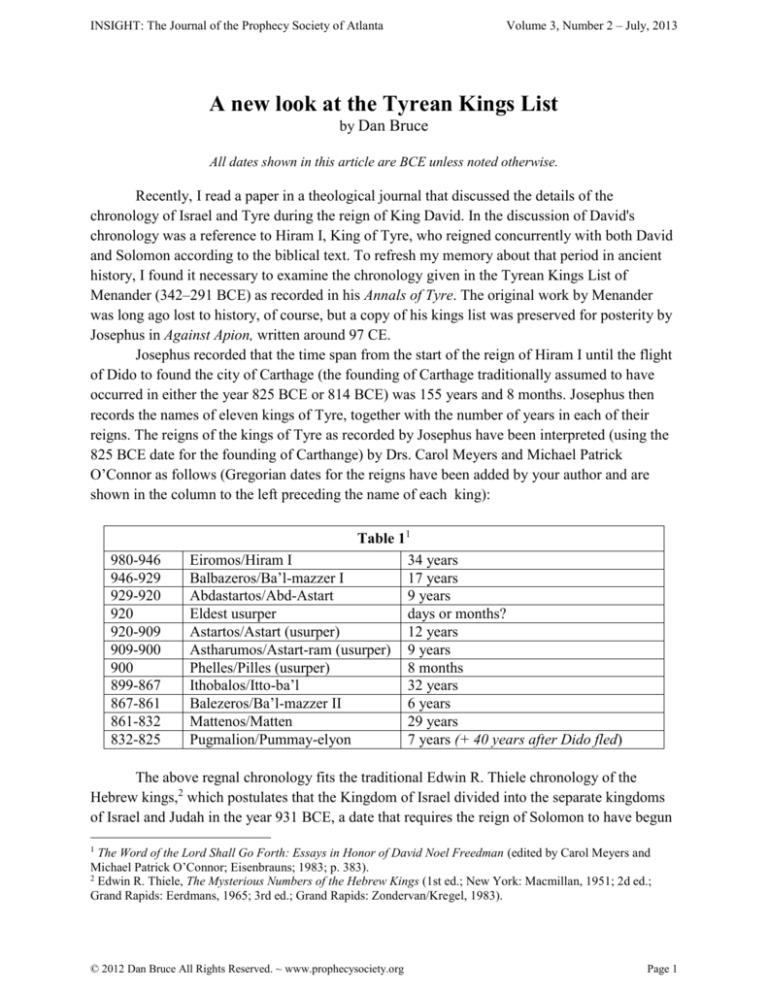
INSIGHT: The Journal of the Prophecy Society of Atlanta
Volume 3, Number 2 – July, 2013
A new look at the Tyrean Kings List
by Dan Bruce
All dates shown in this article are BCE unless noted otherwise.
Recently, I read a paper in a theological journal that discussed the details of the
chronology of Israel and Tyre during the reign of King David. In the discussion of David's
chronology was a reference to Hiram I, King of Tyre, who reigned concurrently with both David
and Solomon according to the biblical text. To refresh my memory about that period in ancient
history, I found it necessary to examine the chronology given in the Tyrean Kings List of
Menander (342–291 BCE) as recorded in his Annals of Tyre. The original work by Menander
was long ago lost to history, of course, but a copy of his kings list was preserved for posterity by
Josephus in Against Apion, written around 97 CE.
Josephus recorded that the time span from the start of the reign of Hiram I until the flight
of Dido to found the city of Carthage (the founding of Carthage traditionally assumed to have
occurred in either the year 825 BCE or 814 BCE) was 155 years and 8 months. Josephus then
records the names of eleven kings of Tyre, together with the number of years in each of their
reigns. The reigns of the kings of Tyre as recorded by Josephus have been interpreted (using the
825 BCE date for the founding of Carthange) by Drs. Carol Meyers and Michael Patrick
O’Connor as follows (Gregorian dates for the reigns have been added by your author and are
shown in the column to the left preceding the name of each king):
980-946
946-929
929-920
920
920-909
909-900
900
899-867
867-861
861-832
832-825
Table 11
Eiromos/Hiram I
34 years
Balbazeros/Ba’l-mazzer I
17 years
Abdastartos/Abd-Astart
9 years
Eldest usurper
days or months?
Astartos/Astart (usurper)
12 years
Astharumos/Astart-ram (usurper) 9 years
Phelles/Pilles (usurper)
8 months
Ithobalos/Itto-ba’l
32 years
Balezeros/Ba’l-mazzer II
6 years
Mattenos/Matten
29 years
Pugmalion/Pummay-elyon
7 years (+ 40 years after Dido fled)
The above regnal chronology fits the traditional Edwin R. Thiele chronology of the
Hebrew kings,2 which postulates that the Kingdom of Israel divided into the separate kingdoms
of Israel and Judah in the year 931 BCE, a date that requires the reign of Solomon to have begun
1
The Word of the Lord Shall Go Forth: Essays in Honor of David Noel Freedman (edited by Carol Meyers and
Michael Patrick O’Connor; Eisenbrauns; 1983; p. 383).
2
Edwin R. Thiele, The Mysterious Numbers of the Hebrew Kings (1st ed.; New York: Macmillan, 1951; 2d ed.;
Grand Rapids: Eerdmans, 1965; 3rd ed.; Grand Rapids: Zondervan/Kregel, 1983).
© 2012 Dan Bruce All Rights Reserved. ~ www.prophecysociety.org
Page 1
Volume 3, Number 2 – July, 2013
INSIGHT: The Journal of the Prophecy Society of Atlanta
forty years earlier in 971 BCE. That scenario would make his fourth year, the year he started
building the Temple in Jerusalem, be the year 967 BCE. Since Josephus wrote that the Temple
was begun in the twelfth regnal year of Hiram, that stipuilation would indicate that Hiram’s first
regnal year occurred in 980/979 BCE, and that is the date accepted by most scholars.
However, the harmonized chronology for the Hebrew kings proposed in my book, Sacred
Chronology of the Hebrew Kings (the entire book is available for reading online at no charge on
my website, click here and see Chapter Two), says that the fourth year of Solomon occurred in
the Hebrew year spanning 1,003/1,002 BCE, and that the Temple was begun in 1,002 BCE,
thirty-four years earlier than the traditional date. So, how can the 34-year difference be
reconciled with Josephus' rather specific figure of 155 years and 8 months that defines the time
span between the start of the reign of Hiram I of Tyre and the founding of Carthage in 825 BCE?
One possible scenario is that the 155 years and 8 months figure used by Josephus should
be calculated from the end of Hiram’s reign, not from the beginning, and that Josephus (or
perhaps the author of his source text, Menander, when the latter was copying from the original
Annals of Tyre) started the individual reigns of the kings list in the wrong place. In that case, the
34-year reign attributed to Hiram should have been attributed to his successor, Baal-Eser I, and
all other successive reigns moved to the next king in the list accordingly, as follows:
Table 2
1014-980
980-947
947-930
930-921
921-909
909-900
900/899
899-867
867-861
861-832
832-787
Hiram I
Baal-Eser I
Abdastartus
Astartus
Deleastartus
Astarymus
Phelles
Ithobaal I
Baal-Eser II
Mattan I
Pygmalion
???
34 years
17 years
9 years
12 years
9 years
8 months
32 years (concurrent with Ahab)
6 years
29 years
7 years (+ 40 years after Dido fled)
With the reigns now realigned to correct for an assumed transmission error in the text by
Josephus or Menander as described above, the length of Hiram’s reign is left unspecified.
However, Josephus does mention that Hiram lived to be fifty-three years old and that Solomon
began his Temple in Hiram’s twelfth regnal year, which would have been 1,002 BCE. That
would mean that Hiram began his reign in 1,014 BCE, at the age of about nineteen or twenty
years old. If Hiram did indeed begin his reign in 1,014 BCE, then he would have reigned for
thirty-four or thirty-five years, with his reign overlapping the reign of David for about eight years
and that of Solomon for at least twenty-six years after David’s death.
Another possible scenario is that the 155 years and 8 months figure cited by Josephus
should be calculated from the end of Hiram’s reign, not from the beginning, as proposed above
© 2012 Dan Bruce All Rights Reserved. ~ www.prophecysociety.org
Page 2
INSIGHT: The Journal of the Prophecy Society of Atlanta
Volume 3, Number 2 – July, 2013
in Table 2, but that the figures for the lengths of the reigns were copied and transmitted correctly
by Menander and Josephus. In that case, the reigns in Table 1 would align as follows, with a
reign of thirty-one years being assigned to the "Eldest usurper" to account for the thirty-four year
difference between my chronology for the Hebrew kings and the traditional chronology:
1014-980
980-963
963-952
952-921
921-909
909-900
900-899
899-867
867-861
861-832
832-825
Table 3
Eiromos/Hiram I
34 years
Balbazeros/Ba’l-mazzer I
17 years
Abdastartos/Abd-Astart
9 years
Eldest usurper
31 years
Astartos/Astart (usurper)
12 years
Astharumos/Astart-ram (usurper) 9 years
Phelles/Pilles (usurper)
8 months
Ithobalos/Itto-ba’l
32 years (concurrent with Ahab of Israel
tribute paid to Shalmaneser III in 871)
Balezeros/Ba’l-mazzer II
6 years
Mattenos/Matten
29 years
Pugmalion/Pummay-elyon
7 years (+ 40 years after Dido fled)
Note that in both scenarios shown in Table 2 and Table 3 the king of Tyre recorded on
Assyrian inscriptions as paying tribute to Shalmaneser III under the name B’al-manzer in 871
BCE (the year of tribute payment according to the kings chronology in my book) would have
been Ithobaal I. The archaeologist W.F. Albright suggested that “manzer” could be translated as
something like “religious votary,” from nzr, “to vow.”3 It has been suggested that the phrase
Ba’li manzer Suraya, which Albright translates as “Ba’li-Manzer the Tyrian”, may also be
translated as “Baal manzer of the Tyrians,” or perhaps “[Itho]Baal, priest of Tyre.” Ithobaal,
called Ethbaal in the Bible, was a priest of Astarte before he killed Phelles and took the throne.
A third scenario, and the one your author prefers, begins with the statement in
Menander/Josephus that Dido fled Carthage 143 years and 8 months after Hiram I began to send
materials to help Solomon build his Temple in Jerusalem. My harmonized chronology of the
Hebrew kings locates the start of the building of the Temple in the year 1,002 BCE,4 so that
would place the flight of Dido as occurring in the year 859 BCE.5 It agrees with the statements in
Menander/Josephus that there was a span of 155 years and 8 months between the start of the
reign of Hiram I and the seventh year of Pygmalion, when Dido fled, and also with Josephus'
statement that Hiram began aiding Solomon's Temple-building efforts in the twelfth year of
W. F. Albright, “The New Assyro-Tyrian Synchronism and the Chronology of Tyre” (l’Annuaire de l’Institut de
Philologie et d’Histoire Orientales et Slaves, tome XIII, 1953; p. 4).
4
Sacred Chronology of the Hebrew Kings ISBN 978-1489509048.
5
The ninth-century BCE date for the flight of Dido from her brother Pygmalion is supported by the interpretation of
the Nora Stone proposed by Frank Moore Cross. He attributed the inscription as applying to Pygmalion. The
inscription itself has been dated by paleographic methods to the 9th century BCE.
3
© 2012 Dan Bruce All Rights Reserved. ~ www.prophecysociety.org
Page 3
INSIGHT: The Journal of the Prophecy Society of Atlanta
Volume 3, Number 2 – July, 2013
Hiram's reign. Since the Temple was begun in 1,002 BCE, that would locate the start of Hiram's
reign in the year 1,014 BCE, and the kings list from Josephus would align as follows:
Table 4
1014-980
… 1002
980-963
963-952
952
952-940
940-931
931
931-900
900-894
894-865
865-818
859
Eiromos/Hiram I
34 years
Solomon starts Temple in Hiram's twelfth regnal year
Balbazeros/Ba’l-mazzer I
17 years
Abdastartos/Abd-Astart
9 years
Eldest usurper, unnamed
less than 1 year
Astartos/Astart (usurper)
12 years
Astharumos/Astart-ram (usurper) 9 years
Phelles/Pilles (usurper)
8 months
Ithobalos/Itto-ba’l
32 years (concurrent with Ahab during
904-900; his daughter Jezebel married
Ahab circa 903)
Balezeros/Ba’l-mazzer II
6 years (concurrent with Ahab during
899-894)
Mattenos/Matten
29 years (concurrent with Ahab during
894-883; as B’al-manzer tribute paid to
Shalmaneser III in 871)
Pugmalion/Pummay-elyon
7 years (+ 40 years after Dido fled)
Dido flees to found Carthage
The chronology shown in Table 4 above disregards the conflicting statements of several
ancient historians that anchor the founding of Carthage to the founding of Rome, the latter
supposedly occurring in the year 753 BCE. In the most popular of these associations, the
founding of Carthage has been placed in the year 814 BCE, based on the chronology of the
Greek historian Timaeus, or in 825 BCE, based on the chronology of the first-century BCE
writer Pompeius Trogus in his Philippic History, which survives only in abridged form in
the works of the Roman historian Justin.
All of this is speculation without further evidence, but the chronological accuracy of the
regnal data given in the Bible for the Hebrew kings, as demonstrated by the exact harmonization
for the reigns of the kings in my book—a harmonization that is achieved without having to
assume scribal error or emendation in the biblical text—requires an earlier set of dates for the
reign of Hiram I than the traditionally accepted dates 980-946 BCE. By adjusting those dates to
1,014-980 BCE as suggested above, the regnal dates for Hiram I of Tyre can be reconciled with
the harmonized chronology of the kingdom of United Israel under David and Solomon.
© 2012 Dan Bruce All Rights Reserved. ~ www.prophecysociety.org
Page 4
INSIGHT: The Journal of the Prophecy Society of Atlanta
Volume 3, Number 2 – July, 2013
About Us …
The Prophecy Society of Atlanta publishes books and papers about a widely-neglected
topic, sacred chronology, and provides access to Bible-based interpretations of chrono-specific
predictive prophecies that you may not have heard explained in your local church or synagogue.
When you examine our publications, you will quickly discover that the chronologies and
interpretations presented by the Society answer many of the questions left unanswered, or poorly
answered, in the study Bibles and biblical commentaries popular today. Our research and its
resulting scholarship are centered on the Bible, which we believe is the revealed word of the one
true Living God, and it is sustained by the belief that the Bible can be understood by anyone who
is genuinely seeking to understand it with an open mind and a seeking heart. We trust that you
will find our Bible-based discussions thought-provoking and spiritually enriching. If there is
anything you don't understand about our publications, ask us about it. We're here to help you as
you seek to understand the mind of God. … read more about us!
To purchase a copy of our books …
The Prophecy Society makes its books available at minimal cost through Amazon.com’s
CreateSpace publishing division, as follows:
Daniel Unsealed
An exposition revealing what the seven chrono-specific predictive prophecies in the Book of
Daniel say about the history of the Jews, Jerusalem, and the Anointed One of Israel.
Paperback, 224 pages (6 x 9); ISBN 978-1489505415. (click here)
Sacred Chronology of the Hebrew Kings
A harmony of the reigns of the kings of Israel and Judah, and how the chronologies and histories
of ancient Egypt and Mesopotamia synchronize with their reigns.
Paperback, 160 pages (6 x 9); ISBN 978-1489509048. (click here)
Synchronized Chronology
Synchronized Chronology of the Ancient Kingdoms of Israel, Judah, Egypt, Assyria, Tyre, and
Babylon from 1006 BCE to 560 BCE.
Paperback, 36 pages (8½ x 11); ISBN 978-1489557773. (click here)
© 2012 Dan Bruce All Rights Reserved. ~ www.prophecysociety.org
Page 5




